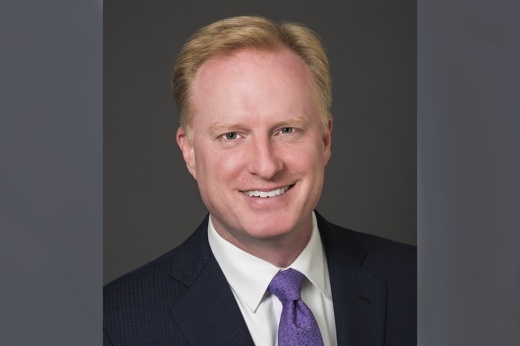Before he was commissioner, Keller was a faculty member and administrator of The University of Texas. Keller shared the board’s initiatives for helping students attend college, challenges within higher education and his vision for adapting to a changing workforce. Answers have been edited for length and clarity.
What does the Texas Higher Education Coordinating Board do?
There’s three major roles. First, we’re the state authorizing agency. When institutions want to offer new degree programs or set up a new college or school, they need to get approval through the Texas Higher Education Coordinating Board.
The second role is the various functions that we administer for the state. We run the state’s student loan programs [and] other financial aid programs. We have a support center where we work with institutions [for] student access initiatives around digital learning, and college and career advising. We’re also charged to be the hub of the state’s combined education and workforce data infrastructure that feeds the state’s education research centers — one at UT Dallas, one at UT Austin and one at the University of Houston.
The third big function is our policy role. I work closely with the governor’s office, the lieutenant governor’s office, the speaker’s office and federal policymakers in the U.S. Department of Education or members of Congress. One of our most important policy roles is specifying and advancing the state’s Strategic Plan for Higher Education. Our new plan is Building A Talent Strong Texas that was adopted by the board earlier this year.
How does the board serve as a resource for higher education?
The most obvious places that we would serve as a resource would be the work that we do on educational workforce data. This year, we’re going to start rolling out more detailed data dashboards for institutions [and] then later in the academic year for the public [and] for policymakers. The data about student enrollment, graduation rates, the wage experiences of graduates, distributions of student debt, institutional finances [and] all of that kind of data [will] be more readily useful and accessible.
We’re working closely with dozens of institutions across the state to support their work around their student success initiatives. We’re providing grants, and then we are also enlisting leading state and national organizations to help support institutions improving and scaling their student success efforts.
What accomplishment would you highlight since you started?
[After the pandemic] Texas was one of only a few states that prioritized higher education for more flexible, more discretionary stimulus dollars. We were able to provide some targeted funding to keep tens of thousands of students enrolled and on track. Within a few days of receiving funds, we were able to work with institutions and get those funds allocated and out the door. Ultimately, those served about 60,000 students that fall of 2020.
What are some of the main challenges these days in higher education?
The pace of change in the economy has accelerated faster than anyone anticipated. There were changes already underway in the economy before the pandemic, but the pandemic accelerated those changes in how we use technology and the ways that we communicate. Our workforce needs of higher skills and more credentials [moved] faster than anyone expected. Our greatest challenge is how we will educate more Texans to higher standards than we’ve ever achieved before, so we can meet our current and emerging workforce needs and be competitive in the future.
How is the board making college more affordable?
One of the things we do for affordability is focused around financial aid, financial aid policy [and] financial aid programs. [The] second thing is college and career advice. We are charged by the Legislature to support college and career advising from secondary schools through our higher education institutions.
The most important thing we can do to make college more affordable is to make sure that folks can complete their high-quality credentials in a timely manner. ... We want to make sure that students are supported in making good decisions about the programs they want to pursue, and that their institutions are supporting them on the way with academic advising [and] academic support. If we can get folks through to earn high-quality credentials and enter the workforce more efficiently, then that reduces those total costs of higher education for students and their families, and helps set them on a better path to career opportunities.
How does the Building A Talent Strong Texas plan improve education?
The plan has three major pillars. The first one is focused on educational attainment. We broadened the scope of the plan to include more attention to adult learners as well as our young working population. [The goal is for 60%] of the working age population to have a degree, certification or another post secondary credential by 2030.
The second thing is we broadened the scope of credentials we’re counting. We want 95% of our Texas students to complete their undergraduate credentials either having no student debt at all or have debt that should be manageable given the typical earnings for their credentials.
Third is research development, innovation and the mission of our organization. Our economy is increasingly dependent on knowledge and competitiveness. The plan emphasizes that across all of these goals, we’ve got to renew our commitment to equity. For the last decade, Texas added more residents than any other state, and 95% of growth was in communities of color. If we don’t advance our goals equitably, then it’s just not possible for us to achieve it.
What do you see for the future of higher education?
We are at the front edge of historic transformation in higher education. We’ll look back on this time the [same] way we look back on changes that happened after the Civil War or after World War II. I think higher education is much more receptive to innovation and change than we’ve seen in many, many years. All of those combined with these changing workforce needs set the stage for exciting transformations in higher education.
Resources: The Texas Higher Education Coordinating Board offers resources for students needing financial help.
College Access Loan Program: This program provides low-interest education loans to Texas residents unable to meet the costs to attend a higher education institution.
Texas Armed Services Scholarship Program: This program encourages students to complete a bachelor’s degree and join the Texas Army National Guard, Texas State Guard or U.S. Coast Guard, or a branch of the U.S. military.
For general resources, visit the Texas Higher Education Coordinating Board's Loans and Scholarship Program page.





